Tattoo Peeling: Is It Normal and How to Fix (Everything You Need to Know)
[ad_1]
The adrenaline of your tattoo session has worn off and now you’re waiting (impatiently, most likely) for your tattoo to heal fully. Then you can show it off to the world!
But wait, what’s happening? My skin is peeling off. Gross!
Yes, this is a very common concern from newly inked people, discovering that their healing tattoo is starting to peel.
So, this article is a rough guide to set your mind at ease. Find out what tattoo peeling is, whether it’s normal, and how to get through this stage of the tattoo healing process.
Tattoo Peeling: What Is It?
Tattoo peeling is the process of your skin starting to peel off during the first week or so after getting a tattoo.
What it looks like: have you ever had glue dry on your skin and then peeled it off? It’s like a white film or very thin paper that’s coming off. And that’s what tattoo peeling looks like. White flakes or larger flecks of skin will start to peel off the tattoo area. You may find that certain areas peel more than others – if you’ve had intense color or black shading in one area, the skin there may peel more.
What’s happening: yes, your skin is peeling. But you’re not going to shed down to the bone! What’s happening is your body is shedding the very top layer of skin, the epidermis. This is a totally normal response for your body.
The process of getting a tattoo damages your skin – the needle literally punctures your body repeatedly. So, your body sees this as trauma or damage to your body. Peeling skin is a response to that, along with scabs, swelling and redness.
So, that’s what is happening.
- Tattoo peeling is natural.
- Tattoo peeling happens in most cases.
- Tattoo peeling doesn’t last forever.
Should You Be Worried?
No, you should not be worried if your tattoo starts peeling. In fact, your tattoo artist should have warned you that this could happen.
Typically, the peeling starts 3 or 4 days after you get your body art. The skin might crack and get dry as well as peel. Your tattoo artist should have given you instructions for how to clean and treat the tattoo.
Importantly, you shouldn’t pick at the skin when it starts to peel. Just let it naturally slough off.
Fading
You might be worried that the peeling is removing the beautiful colors and lines of your tattoo. While the peeling phase can make the tattoo look mottled and hazy, it’s not actually impacting the tattoo itself.
The tattoo needle deposits ink into the dermis layer of your skin, which your body cannot and will not shed.
You’ll find that once the peeling stage is over and your skin is almost healed, the tattoo will look even brighter, sharper and clearer than before. Like a snake shedding its skin, this is just a process that you need to go through, and you’ll feel (and look) much better afterwards.
Also Read:
- How Do I Keep My Tattoo(s) From Fading?
- The 10 Best Tattoo Sunscreens for 2022: Protect Your Tattoos From Fading
The Tattoo Peeling Stages Guide

Okay, so now that we know tattoo peeling is a normal response, here’s exactly how it goes down. We’ve separated this process into days, and then weeks, so you know when the peeling will start and what happens before/after the peeling stage.
Day 1
Your tattoo will be red, swollen and oozing. It’s going to be quite painful – like a sunburn. But ultimately, you’re unlikely to see much skin peeling or flaking at this stage.
Day 2
The next day, you should be a bit more prepared about what to expect! The swelling should be significantly going down at this stage, and you should find oozing and redness starting to reduce too.
Day 3
When the oozing stops, which is usually days 2 to 3, the skin will begin to dry out. Scabs will start to form (slowly) and the itching will begin. You may also see your skin start to crack.
Day 4
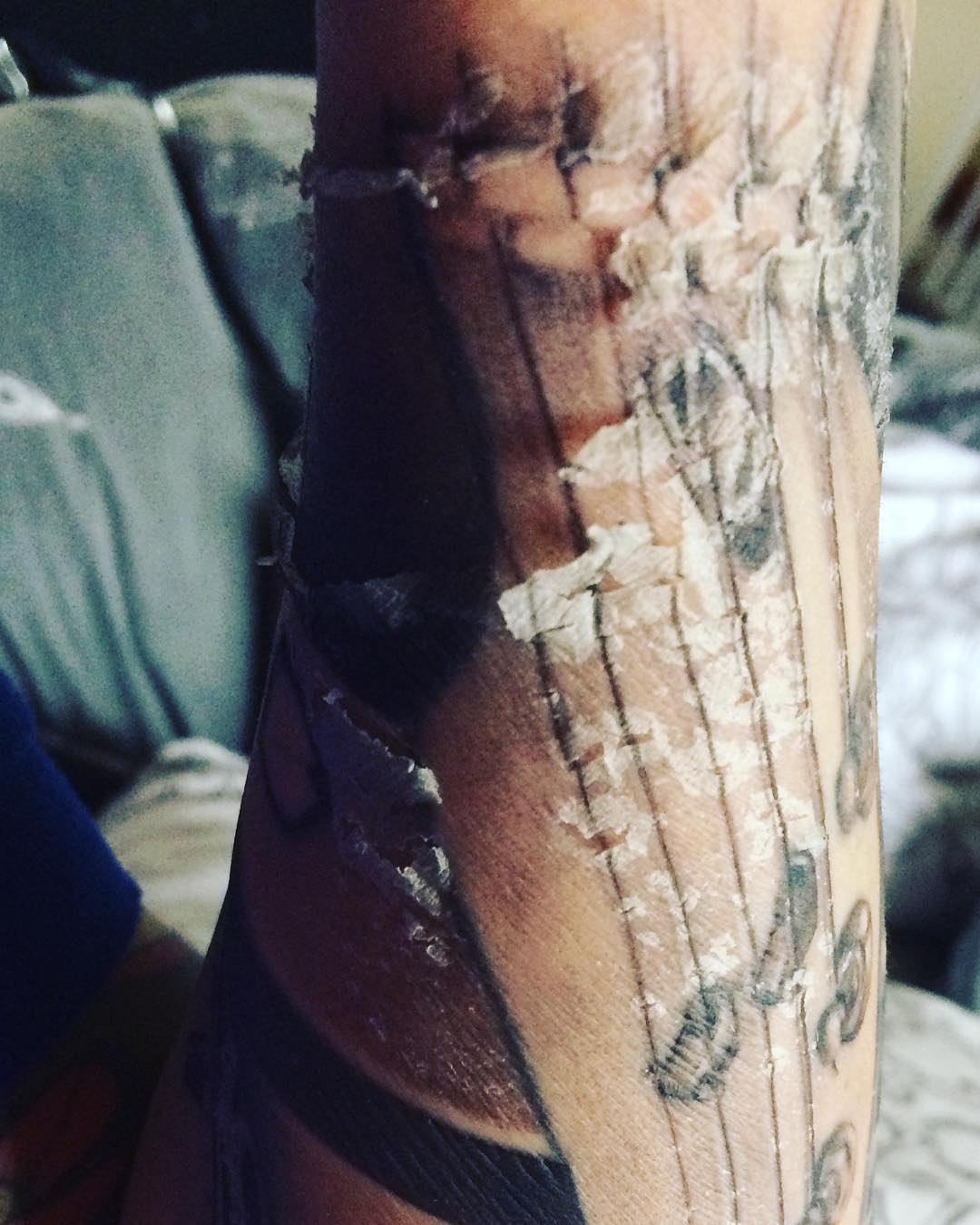
This is often when the peeling begins, and you may start to notice dry flakes of skin start to pull away from your body. You’ll also see any scabs that have formed start to break away from your skin – it’s important to let this happen naturally.
Don’t pull off any scabs or flakes! Prolonging the healing process and causing scars will disfigure your tattoo.
Week 1
During the first week, from day 1 to day 7, you’ll chance from red and oozy to white and flakey. It’s going to itch and maybe even sting.
Things to watch out for during this week:
- Any symptom that gets worse rather than stays the same or gets better,
- Fever-like symptoms – dizziness, fatigue, high temperature, etc.,
- Dirt or other things that could cause an infection – make sure you follow your tattoo artist’s instructions for cleaning and aftercare.
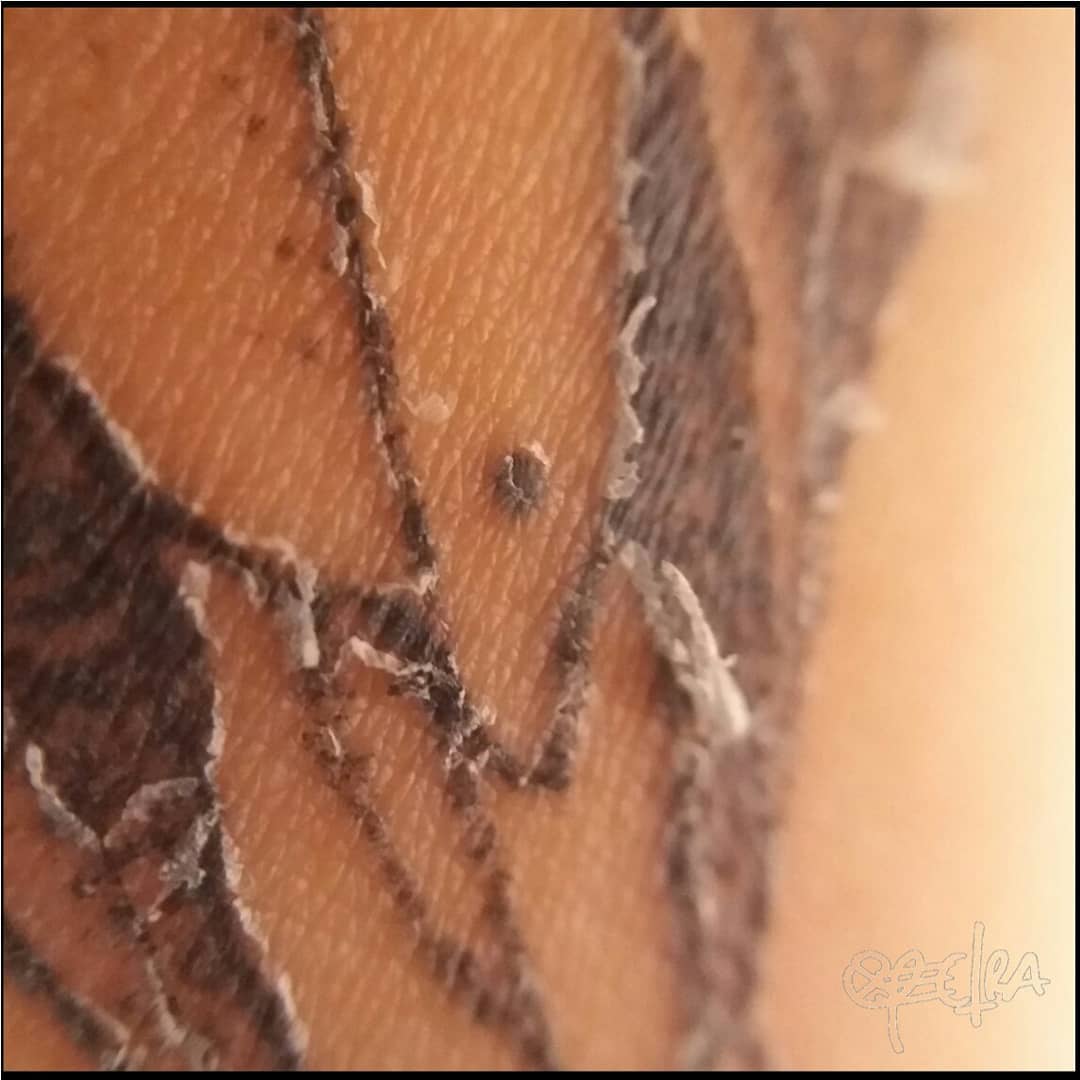
Week 2
By week 2, you should have hit your peak tattoo peeling stage. Your entire tattoo may be peeling and flaking large, sometimes surprisingly thick, pieces of dead skin. This is totally normal and just let the skin come off naturally.
By the end of week 2, most (if not all) of the dead skin should have flaked off. Don’t panic if it hasn’t – if it’s slowly coming to a stop, you’re on the right track.
Remember, everybody heals differently, on a different time scale.
As the skin peels off, your tattoo beneath it should be more vibrant in color with sharper lines. If there are patches or missing parts, don’t panic. You just need to book in a touch-up session when your tattoo is completely healed.
Tattoo Peeling Off When Applying Lotion: Why?
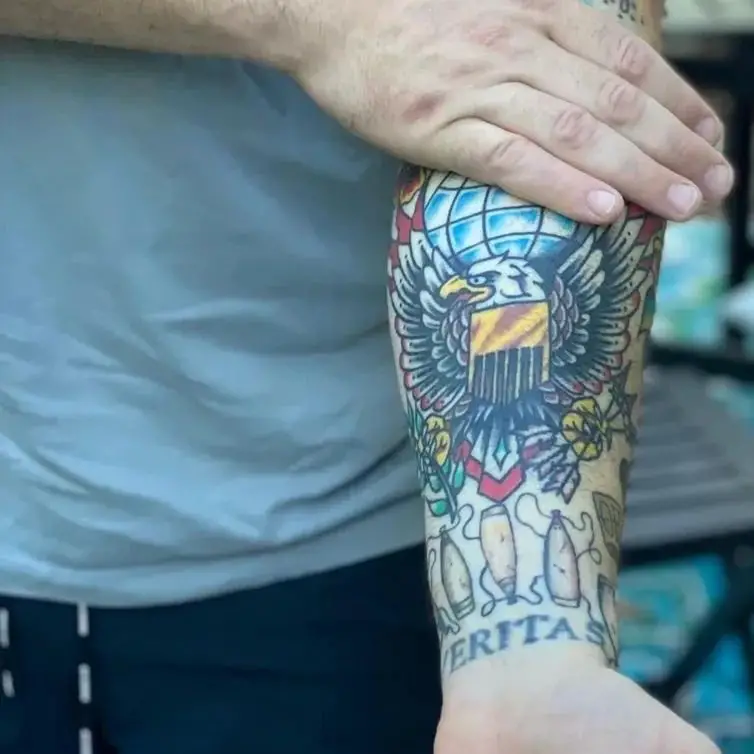
Applying lotion is important for your tattoo aftercare. It keeps your skin soft and pliable, even after washing it regularly. But it’s important that you don’t put on too much lotion. A very wet and warm environment is great for bacteria… ew.
So, your tattoo artist should advise you to apply a small amount of lotion. Pat it into your tattoo, the use a paper towel to very gently pat over it again – this will remove any excess lotion that your skin can’t absorb.
Now, the important thing to note. Apply lotion won’t prevent peeling. Peeling is your body’s natural response, and no amount of lotion will stop it from happening. Applying a small amount of lotion will keep the skin soft and prevent the skin from becoming brittle, which makes the peeling process more comfortable. Lotion can also soothe the itchy hot sensation.
So, why is your tattoo peeling off when you apply lotion? The answer is because that’s how your body heals! Whether you apply lotion or not, your tattoo will peel anyway. So why not follow the correct aftercare instructions and moisturize your tatt to help it heal.
Tattoo Peeling Before and After
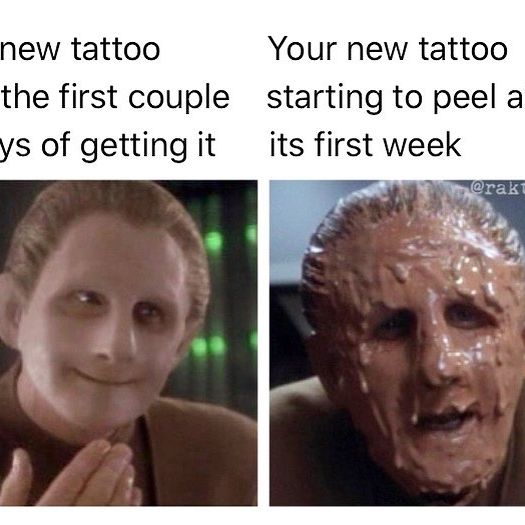
Okay, this meme is pretty good! When you first get your tattoo, it looks so fresh and vibrant. Often the skin is slightly raised where the needle has imbedded ink, especially for fine line tattoo designs. But that doesn’t last. Over the next couple of weeks, your tattoo will go through stages of oozing, scabbing, and peeling as your body heals over the ink.
You can’t avoid this healing process and you really shouldn’t hinder it, as this could alter the tattoo design!
Generally, your tattoo will have a white cast over it during the peeling stage, but afterwards it will be as bright and vibrant as when you first got inked. Although the skin won’t be raised, some colors will appear brighter than before.
On the other hand, you might notice some small patches where the ink hasn’t taken. If this is the case with your tattoo, you need to book a touch-up session.
Let’s take a look at some before and after photos to find out what’s in store for your peeling tattoo.
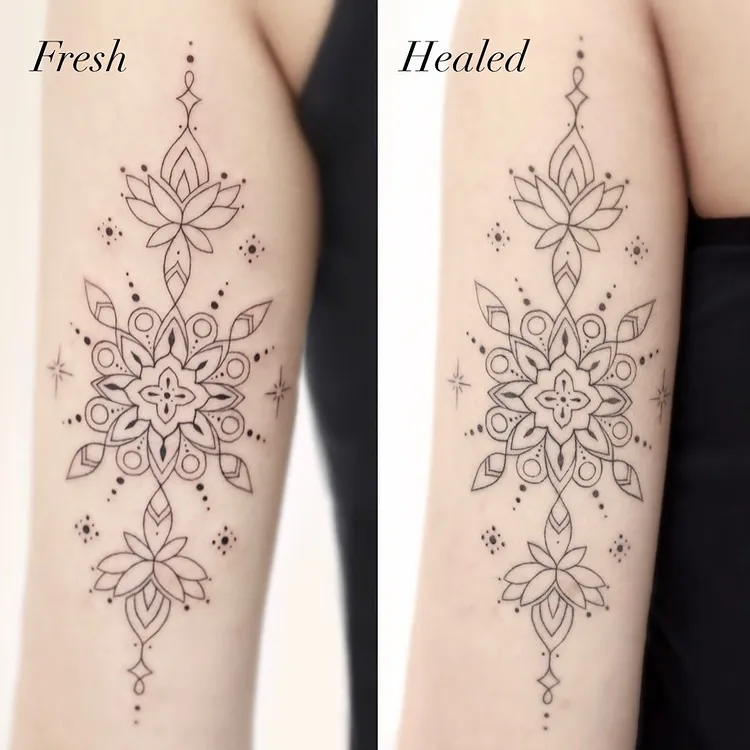
This simple linework tattoo is a wonderful example of how black lines can dull a little over the first month of getting a tattoo. When the ink is still fresh and the surface of your skin is raised, the tattoo can look striking.
A month later – after peeling and healing completely – the lines are still bold and strong, but just a little bit faded compared to when they were initially inked.
We love this ornamental arm tattoo! It’s also been inked perfectly, with no need for a touch-up session to fill in any missed lines or mistakes.
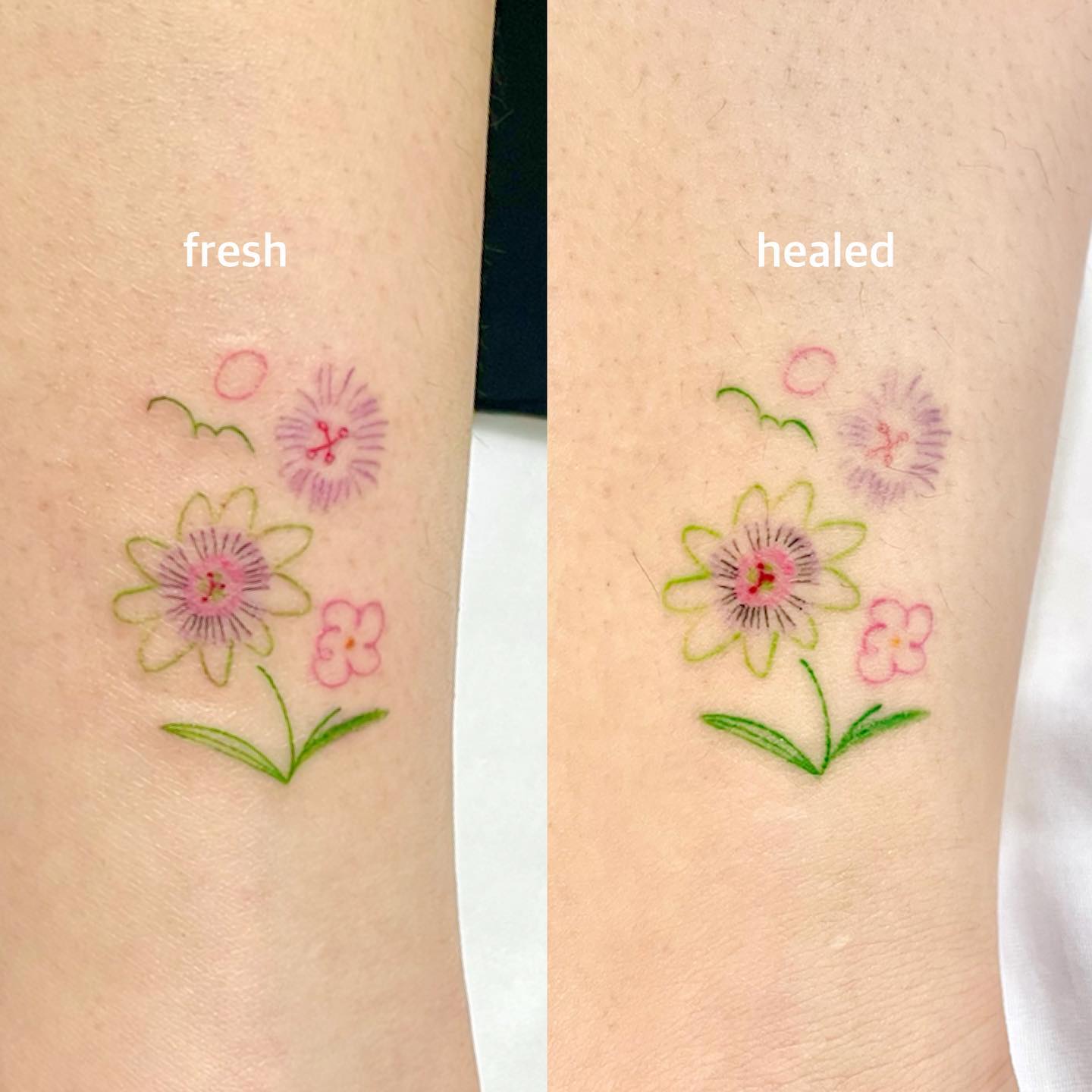
This tattoo before and after photo gives you a better idea of how colors change over time. The ‘before’ was taken just when the tattoo artist had finished inking. The ‘after’ was taken a few weeks to a month later, when the tattoo had peeled, scabbed, and completely healed.
The green and pale pink colors have become even more vibrant after the tattoo healing process. However, the fronds on that flower in the top right of the design has faded a little and is noticeably lighter than other areas.
Does it warrant a touch-up session to go over that area and create a bolder line? Well, that’s up to the person that got inked.
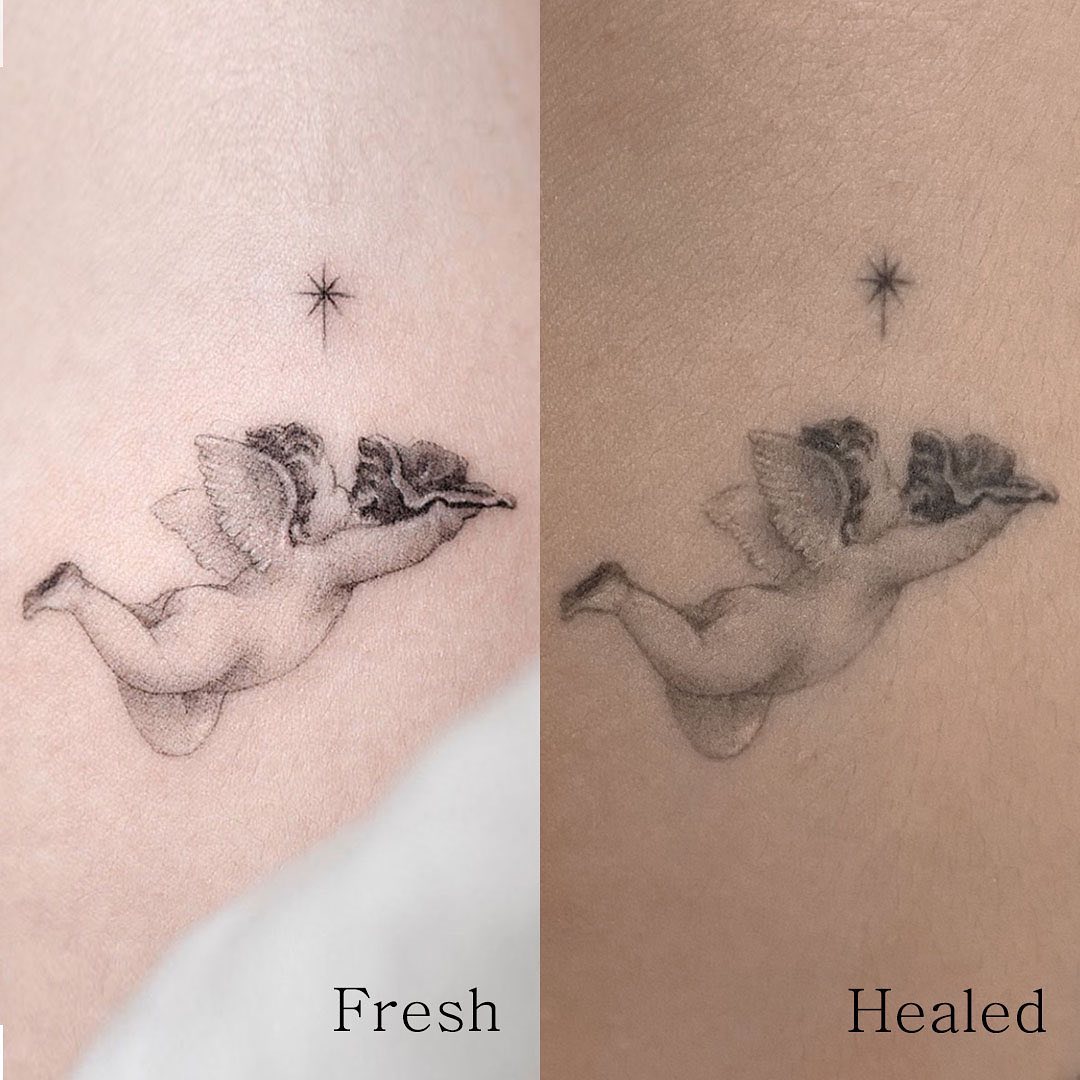
This before and after photo is a little different. The ‘fresh’ was taken right after the tattoo artist had finished the final session, but the ‘healed’ photo was taken 8 months later. So, this gives you a good idea of how much fading to expect in the first half year after the tattoo has peeled and healed.
Overall, it’s still a beautiful tattoo with clear lines and great shape. No touch-ups necessary. If you’re interested in getting a tattoo like this, try to find a tattoo artist near you who specializes in micro-realism.
How to ‘Fix’ Tattoo Peeling
Tattoo peeling isn’t a problem for your body, it’s a solution! Your skin is peeling because your body is healing the area that was damaged to get a tattoo.
The only way to ‘fix’ tattoo peeling is to go through it. Don’t try to speed up the process by pulling off the skin, as this could be painful, cause damage, and maybe even lead to an infection. Instead, let the skin flake away naturally.
You may need to vacuum your home frequently as you shed skin!
Here are some other tips to help you get through the peeling process as comfortably as possible:
- Apply small amounts of lotion and pat them onto the tattoo – don’t rub or scrub. The gently patting motion will naturally dislodge some of the peeling skin. Furthermore, the lotion will keep your skin soft and supple rather than brittle, thus making the peeling a little more comfortable.
- Keep the tattoo open to the air, but also clean. Don’t be tempted to bandage up the tattoo again. The only way to get through the peeling process is to let the skin come off, not bandage it tightly back on.
- Don’t expose the tattoo to sunlight during this stage. Instead, wear light and moisture-wicking clothes. Sports clothes, bamboo, and breathable cotton are all good, so long as they aren’t tightly pressed to the tattoo. No skinny jeans, for example.
Keep the tattoo clean, moisturized, and protected from sunlight when you are out and about is the best way to go. You can’t really avoid the skin peeling, so just be prepared to clean up lots of dead skin throughout this week of your tattoo healing!
Troubleshooting
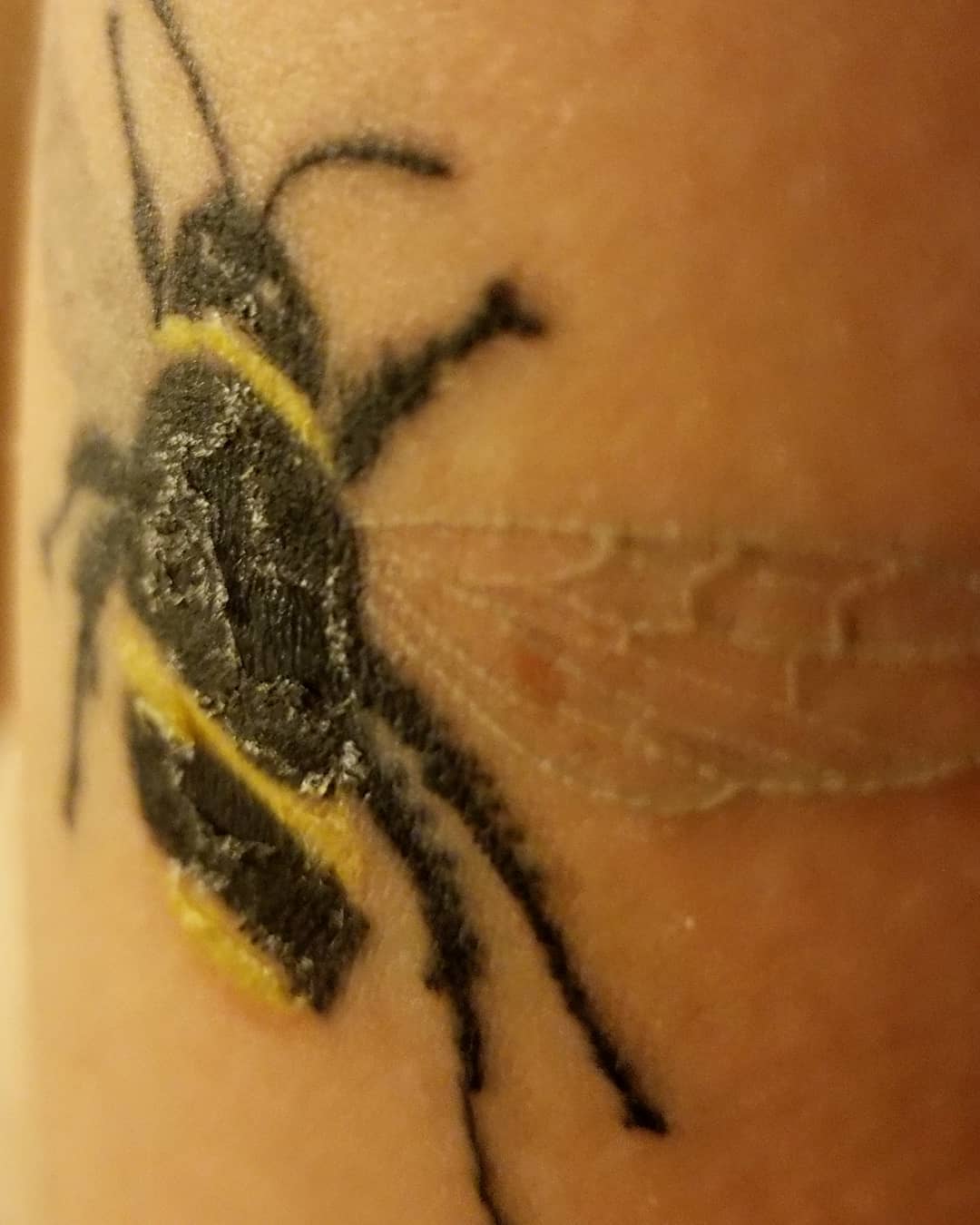
If your tattoo peeling experience isn’t quite what you expected, try these troubleshooting topics.
Tattoo Faded After Peeling
Some inks look brighter after the peeling stage, and some look slightly duller. You can see this for yourself in our ‘before and after’ section above. But is there anything you can do about this?
Well, perhaps.
While you can’t make the ink look as fresh as it did the day it was needled into your skin, there are still ways to keep your tattoo bright and vibrant.
Try using tattoo balms, lotions, oils, and moisturizers that are designed to brighten the colors of your tattoo. Make sure to wait until the peeling is over before applying these products.
- Mad Rabbit Tattoo Enhance Balm & Aftercare Cream – scented with frankincense and lavender, this is an all-natural nourishing balm that with gradually brighten and sharpen your tattoo… no matter how old your ink is.
- Viking Revolution Tattoo Care Balm for Before, During & Post Tattoo – this is our top choice for tattoo beginners, as it can be used before your tattoo, during the aftercare, and then when the tattoo is completely healed to keep it looking bright and fresh.
- Mandrill Tattoo Enhancer Butter – a tattoo balm and skin moisturizer that doubles as a beard balm and scar remover, apparently. You can even use it to soothe your sunburn and apply it while your tattoo is healing (in small amounts).
Tattoo Missing Ink After Peeling
If you pick at the flaking skin, or you accidentally pull of scabs before they’re ready to fall off naturally, you can dislodge some of the ink. This is a big problem and can lead to missing chunks of your tattoo once the peeling stage is over.
Unfortunately, the only way to fix it is to go back to your tattoo artist and get them to fill in the blanks. That’s why proper aftercare is so important!
Follow our instructions for aftercare while your tattoo is peeling to avoid this quandary altogether.
Tattoo Still Peeling After 2 Weeks
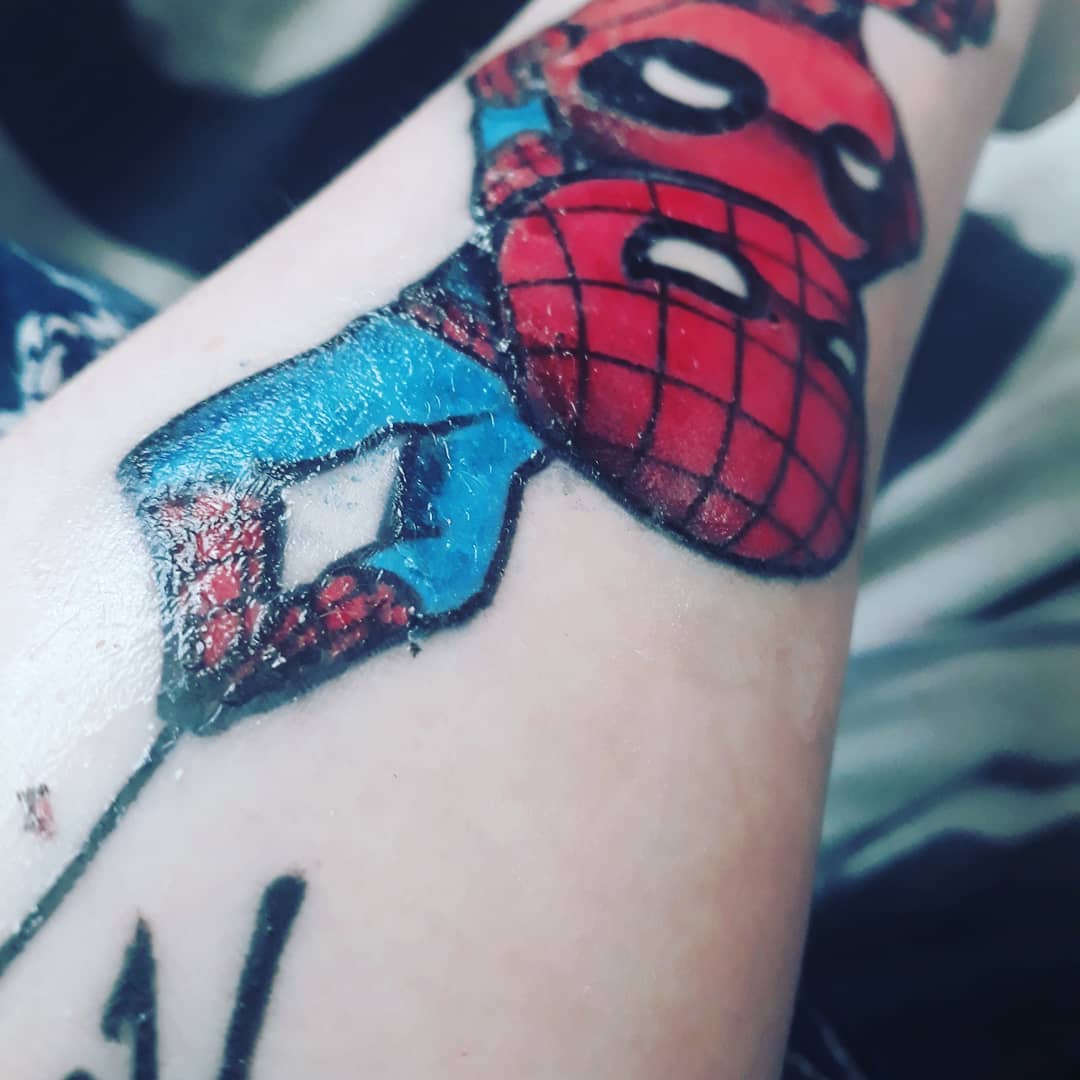
As mentioned above, the timeline will differ from one body to another. If your tattoo was late to start peeling, it may be late to finish. Furthermore, if your tattoo is quite large, you’ll have a lot of skin to slowly peel off.
Don’t panic if your tattoo is still peeling after 2 weeks. Just keep it moisturized and clean. So long as there are no signs of an infection, you are on the right path. You just need to be patient and trust the process.
Your body will stop peeling when it is ready. You can’t force it to stop.
Tattoo Not Peeling at All
Not all tattoos will peel so noticeably. A very fine line tattoo will have minimal peeling, for example. You might find that after some light scabs, there’s no peeling at all.
Furthermore, you might not realize that your skin is peeling if your tattoo is in a location that’s hidden by clothes. Overnight and during the day, your skin will rub against the clothing and flakes of skin will naturally fall off.
So, it may be the case that your body is peeling… you’ve just not seen it.
Finally, if your tattoo is still red, oozy, and even a little swollen, you just haven’t reached the peeling stage yet. And that’s completely fine! If your body needs more time to heal, just be patient and let it get to work.
The most important thing to do is make sure that your tattoo doesn’t get infected, and you don’t try to force the skin to peel.
Also Read: Why Isn’t My Tattoo Peeling: 6 Things You MUST Know
FAQs
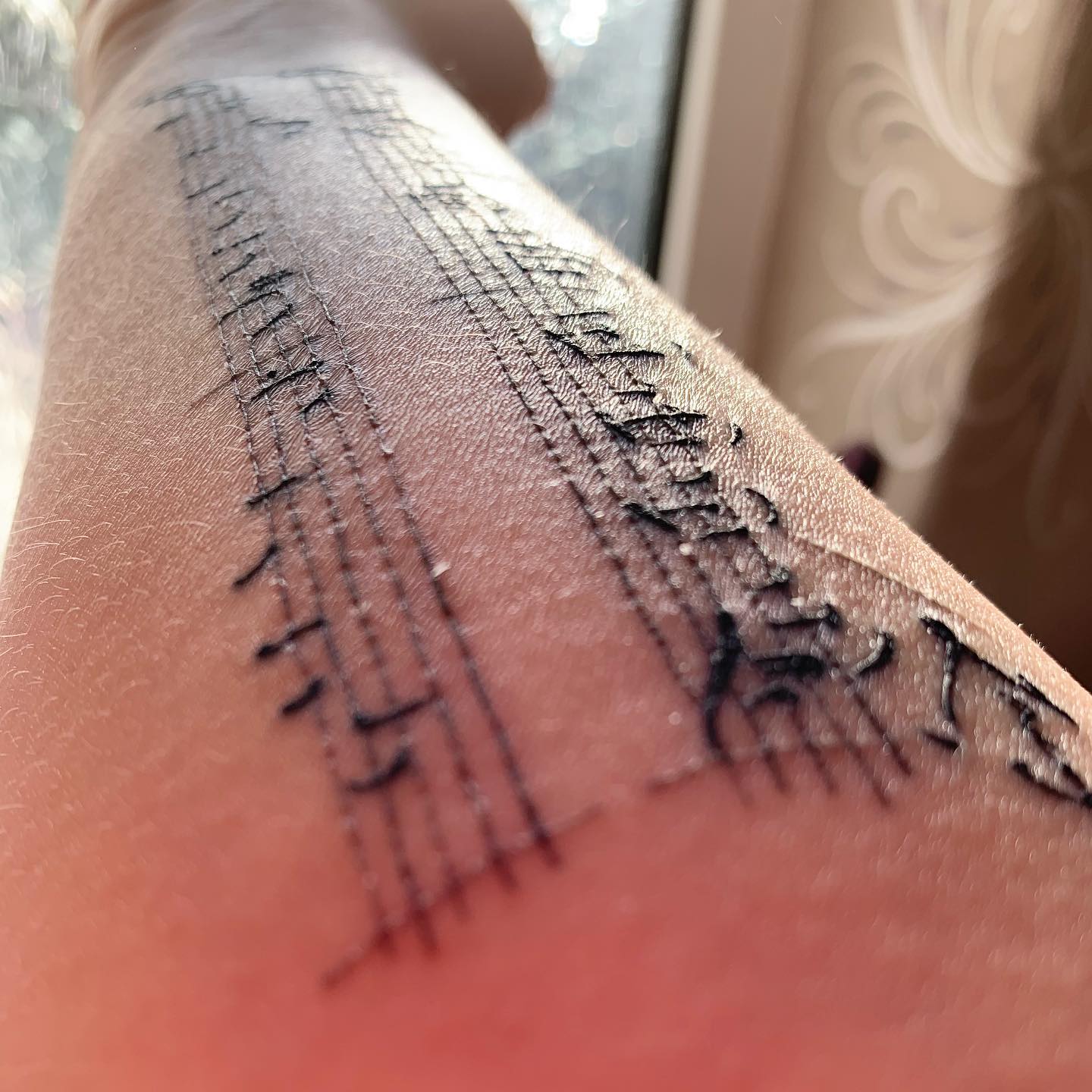
How long does tattoo peeling last?
Usually 1 to 2 weeks, but it does depend on your body and how large the tattoo is. You can expect the tattoo to start peeling, as the skin cracks and hazes, 3 to 4 days after the tattoo session ends. This is completely normal, so don’t panic!
Why is my tattoo peeling?
Tattoo peeling is where the epidermis layer of your skin starts to shed. This is totally normal, it’s your body’s natural response to the tattoo process. Your body thinks of the tattoo as an injury, so it’s shedding that top layer of skin to try and heal. You may also get scabs!
Of course, the tattoo needle deposits the ink far deeper into your skin, so this peeling shouldn’t remove the tattoo itself. In fact, your body uses white blood cells to slowly attack the ink and remove it over time (decades and decades) which is why tattoos fade over the years.
Is tattoo peeling normal?
Yes, it’s a totally normal response that your body makes during the healing process. It’s normal for the area to ooze, scab, crack, peel, and itch during the healing phase. Of course, you should also watch out for signs of an infection.
Peeling alone isn’t a sign of an infection, but if you start to experience any fever-like sensation or have excessive oozing and gunk coming from your tattoo, you may want to seek medical attention.
Better safe than sorry!
What does tattoo peeling look like?
When your tattoo peels, it will haze over and white flakes or strips of skin – like very thin paper – will start to peel off the area. If you’ve ever experienced bad sunburn, the process of your skin peeling as it heals is very similar.
This image demonstrates what tattoo peeling looks like:
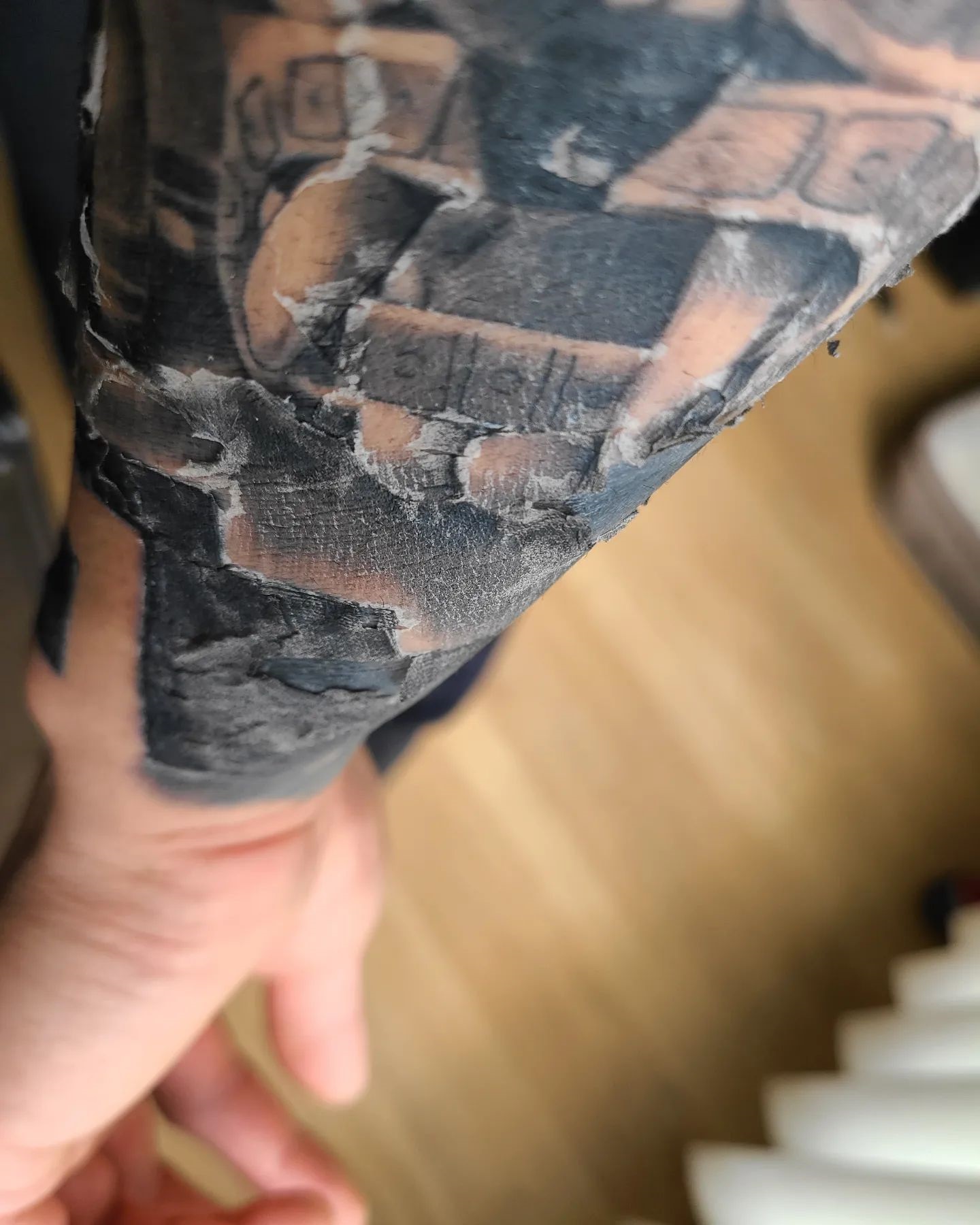
When does tattoo peeling start?
The peeling usually starts 3 to 4 days after the end of your tattoo session, but it will depend on your body and how it responds to the tattoo. Furthermore, the extent to which your skin will peel depends on the tattoo itself.
If you have a full arm sleeve tattoo that’s intensely colored and completely filled, it may peel quite extensively. On the other hand, if you have a minimalist simple line tattoo – like the one pictured below – you might scab over but not peel noticeably at all.
So, don’t panic if how your tattoo peels is not exactly the same as how other tattoos peel. Just follow the aftercare steps your tattoo artist provided!
[ad_2]
